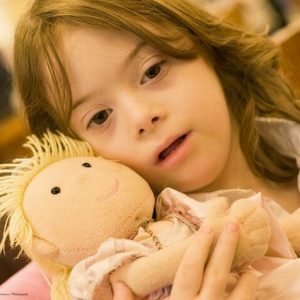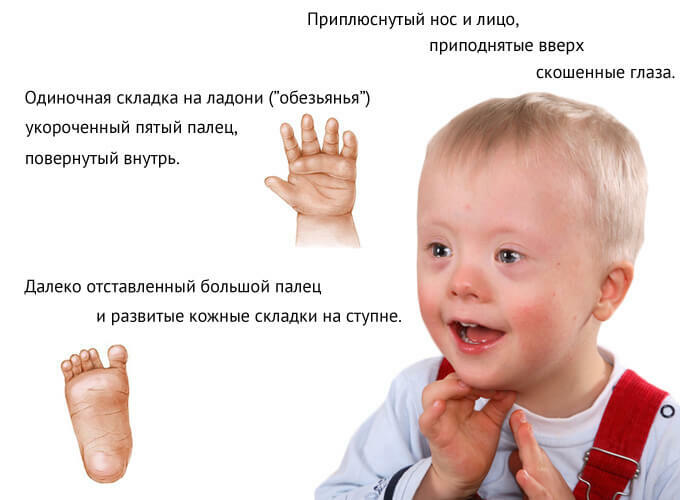Down Syndrome: causes, signs and associated pathologies
 Down syndrome is a pathology that everyone and everyone knows about.Especially often the question of Down syndrome worries future mothers, who are preparing for the first analysis( screening) during pregnancy.About this pathology much is known to medicine and science, and for the first time scientific studies on Down's syndrome were published in 1886 by the scientist John Down( which he gave the name of pathology).
Down syndrome is a pathology that everyone and everyone knows about.Especially often the question of Down syndrome worries future mothers, who are preparing for the first analysis( screening) during pregnancy.About this pathology much is known to medicine and science, and for the first time scientific studies on Down's syndrome were published in 1886 by the scientist John Down( which he gave the name of pathology).
In recent decades, statistics have pointed to the birth of one child with a considered pathology of 700 newborns, but in just a few recent years, indicators have changed - now doctors say that one child with Down syndrome is born to 1,100 babies.Such improvements have become possible due to the achievements of modern medicine - doctors can now diagnose the pathology in question even during pregnancy, which allows a woman to choose either for the birth of the baby or for the artificial abortion.
Both boys and girls are born with Down syndrome equally, the disease has no ethnic distribution and is found everywhere.
Contents: Down syndrome: causes of pathology Forms of Down syndrome Diagnosis during pregnancyDown syndrome: causes of pathology
The reasons for the development of the pathology in question are in the intrauterine formation of the chromosome component of the fetus.This happens with violations, characterized by the formation of copies of genetically incorporated material of 21 chromosomes.Thus, a healthy child has 46 chromosomes, and with Down's syndrome there are 47 of them.
Note: appearance of one superfluous chromosome in the child's body is absolutely not related to bad ecology, harmful habits of parents, long reception of medications.Down Syndrome is a random chromosomal "event" that can not be prevented or altered.
Doctors confidently state that the probability of having a child with this pathology directly depends on the mother's age:
- from 20 to 24 years - the probability is 1 to 1562;
- at the age of 25-35 years the probability rises and makes 1 to 1000;
- age 35-39 years - the risk of having a child with Down syndrome is already 1 in 214;
- age over 45 years - 1 to 19.
 As for fathers, the risk of having a child with the pathology in question is practically independent of them, only at the age of 42 and above the probability of a man's influence can be appreciable.
As for fathers, the risk of having a child with the pathology in question is practically independent of them, only at the age of 42 and above the probability of a man's influence can be appreciable.
There is no trace of the inheritance of Down syndrome transmission from parents to children.But there is a 30-50% risk of having a child with a Down syndrome with the same pathology.
Forms of Down's Syndrome
In medicine, there are three forms of the examined pathology:
- Trisomy.It is characterized by the presence of three instead of two chromosomes, often children with such a form of Down syndrome are born in women with diseases of the reproductive system, the birth of dead children, frequent miscarriages in the anamnesis.Translocation Down syndrome.
- .In this case, the gene or fragment of the chromosome is transferred to another position.This can happen in the "original" chromosome, but the gene / fragment of the chromosome may also join another chromosome.The total number of chromosomes remains unchanged - 46. According to statistics, in 50% of cases of the birth of children with Down's syndrome, the translocation form is diagnosed.
- Mosaicism.It is manifested by a combination of cells with a normal and atypical number of chromosomes.Only in 1% of births of children with Down syndrome is this type of pathology revealed.Children with mosaiczemic Down syndrome usually have high intellectual abilities in comparison with other forms of pathology.
Diagnosis during pregnancy
Diagnostic measures in the first trimester
This pathology is genetically determined, so it can be diagnosed during fetal intrauterine examination.Modern medicine accurately determines this pathology already in the early stages of pregnancy through a combined screening analysis. What is meant by this survey:
- definition of a pregnancy hormone HCG in the venous blood of a prospective mother - with the development of a baby with Down syndrome, this indicator will be greatly overestimated;
- determination of plasma protein level A of a pregnant woman;
- performing ultrasound examination of the fetus and determining the size of its collar zone - if this figure exceeds 3 mm, then the probability of developing a fetal Down syndrome is very high.
The combined screening assay is performed in a strictly defined period of pregnancy - from 11 weeks to 13 weeks 6 days.
 If in the course of such a survey in the first trimester of pregnancy a combination of all three results is revealed, the probability of the birth of a baby with the pathology in question is 86%.To enable the woman to decide exactly how to deal with pregnancy, doctors conduct an additional study - transcervical amnioscopy.A similar study is to take chorionic villi through the cervix, which are sent for histological examination.Such an analysis allows to confirm with 100% accuracy or refute the formation of a fetus with Down syndrome.
If in the course of such a survey in the first trimester of pregnancy a combination of all three results is revealed, the probability of the birth of a baby with the pathology in question is 86%.To enable the woman to decide exactly how to deal with pregnancy, doctors conduct an additional study - transcervical amnioscopy.A similar study is to take chorionic villi through the cervix, which are sent for histological examination.Such an analysis allows to confirm with 100% accuracy or refute the formation of a fetus with Down syndrome.
Note: transcervical amnioscopy is not mandatory research, as doctors can not give guarantees of a successful course of pregnancy in the future.The decision to conduct such an analysis is made only by future parents.
In 2004, the British Medical Journal published research data on the use of known screening techniques for diagnosing Down syndrome in the first trimester.The result was conclusions about the advisability of using just a combination of diagnostics, since, for example, it is almost impossible to establish the fact of the formation of a fetus with Down syndrome only by ultrasonic examination of the size of the collar zone of the fetus( accurate, truthful results take place only in 20% of cases).
Diagnostic measures in the second trimester
Between 16 and 18 weeks of gestation, combined screening is also carried out:
- determination of the level of HCG in a woman's blood; Down syndrome will indicate a value above 2 MoM;
- determination of a-fetoprotein in the blood of a pregnant woman - in the pathology under consideration, the indicator will be below 0.5MoM;
- determination of free estriol in a woman's blood - less than 0, 5 MoM indicates Down syndrome;
- definition of inhibin A in a woman's blood - for Down syndrome, the indicator will be higher than 2 MoM.
In addition, ultrasound examination of the fetus is mandatory. During this survey, Down's syndrome will be indicated by:
- small fetal sizes that are inappropriate for the period of pregnancy;
- small size of the upper jaw;
- only one artery is defined in the umbilical cord instead of two;
- absence( or significant shortening) of the nasal bone in the fetus;
- heart palpitations;
- saliva or complete absence of amniotic fluid;
- an increase in the size of the bladder in the fetus;
- smaller size of the femoral and humerus of the fetus compared to the norms for the current period of pregnancy.
If all these signs are combined, then the woman will be asked to conduct a genetic study of :
- transabdominal cordocentesis, performed by puncturing the umbilical cord;
- transabdominal aspiration of the placenta villi.
The material obtained from the study is sent to the laboratory for histological examination.This is what makes it possible to diagnose Down's syndrome with 100% confidence.
Please note: only accepts the decision to continue or abort the pregnancy.Even if fetal pathologies are found to be incompatible with life, no one will be able to force abortion on a woman.
Symptoms of Down's syndrome in newborns

Down syndrome manifests itself in numerous signs, they are well defined immediately after the birth of the child.These features include:
- saddle nose;
- concave form of little fingers;
- skin folds at the inner corners of the eyes;
- wrong shape of the ears;
- short extremities( both upper and lower);
- oblique incision of the eyes;
- flattened facial skull;
- flattened wide palms;
- weak muscle tone;
- shortened skull;
- open mouth;
- short neck with pleats;
- horizontal fold on the palms;
- a large distance is clearly visible between the first and second toes;
- small chin;
- short fingers;
- is a thick tongue with numerous furrows.
If a child with Down syndrome is born, all of the above signs will be present simultaneously.To clarify the diagnosis it will be necessary to undergo a specific genetic study for the karyotype.
More details on the pathology - in the video review:
Associated pathologies in Down syndrome
The pathology under consideration is a complex of diseases.Therefore Down syndrome always has concomitant diseases.
Congenital heart diseases
occur in 40% of children with Down's syndrome, the appearance of heart disease is associated with anomalies in the development of the heart muscle, which is due to the presence of genes in the extra chromosome.It is worth knowing that even congenital heart disease may not immediately manifest itself, as a rule, this pathology is diagnosed several months after the birth of a baby with Down syndrome.
Most often, against the background of the syndrome under consideration, the noninvasive interventricular and interatrial septa are diagnosed.It is much less common for the tetralogy of Fallot and the non-spreading of the botulian duct.If the congenital heart disease is the cause of circulatory disorders, the child will need surgical treatment.
Vision disorders
occur in 66% of births of children with Down syndrome.Possible violations include:
- nystagmus;
- corneal opacity;
- protrusion of the cornea( visually it looks like a cone);
- increased intraocular pressure;
- cataract;
- myopia.
It is quite realistic to reduce the risk of developing such pathologies: the parents of a child with Down syndrome should undergo a preventive examination at an oculist at least once a year and limit the viewing of the TV as much as possible, while studying at the computer.
Frequent infectious diseases
In children with this pathology, immunity is reduced, so infectious diseases they get sick very often.With special care, one must treat diseases of the trachea, bronchi, tonsils and pharynx.Parents should remember this feature of children with Down's syndrome and protect them from contact with obviously sick people, protect them from hypothermia.
Food reflux
This pathology is characterized by throwing a portion of food mixed with gastric juice from the stomach into the esophagus.Prevent such casts, thereby easing the condition of the baby, you can only one way - feed it often and in small portions.
Insufficient thyroid activity( hypothyroidism)
Diagnosed in 15% of cases, characterized by the fact that the thyroid gland produces an insufficient amount of hormones.There is a violation of metabolic processes, in the human body with Down syndrome, little energy accumulates, which leads to sluggishness of such people and the appearance of excess weight.
Atresia or stenosis of the duodenum
occurs in 8% of cases, characterized by partial or complete obstruction of the intestine, which manifests itself literally in the first days of the child's life.A symptom of this concomitant pathology in Down's syndrome will be vomiting, starting a few minutes after eating.Solve the problem will help only surgical treatment.
 Approximately 8% of births of children with the syndrome under consideration are diagnosed with episyndrome, which is caused by focal brain damage.Typically, epileptic seizures occur in people with Down's syndrome after severe stress or a transmitted infectious disease.Such seizures are manifested by throwing back the head, rolling up the eyes, pulling on the lower and upper extremities, hallucinations, fever, palpitations and severe abdominal pain.
Approximately 8% of births of children with the syndrome under consideration are diagnosed with episyndrome, which is caused by focal brain damage.Typically, epileptic seizures occur in people with Down's syndrome after severe stress or a transmitted infectious disease.Such seizures are manifested by throwing back the head, rolling up the eyes, pulling on the lower and upper extremities, hallucinations, fever, palpitations and severe abdominal pain.
Hearing disorder
This pathology can be caused by anomalies in the development of the auditory ossicles that are located in the inner ear.Often hearing loss in a child with Down's syndrome occurs after the transferred inflammatory diseases of the hearing organ - parents should not only prevent such diseases, but in time and fully treat existing pathology.
Sleeping breathing in sleep( apnea)
 There is a decrease in airways and blocking air access to the lungs, due to the weak tone of the pharynx and the large size of the tongue.To reduce the manifestations of apnea, parents should put the child to sleep in the position on the side, very small - to put under the back of the platen from the blanket, so that the child does not turn over on his back in a dream.
There is a decrease in airways and blocking air access to the lungs, due to the weak tone of the pharynx and the large size of the tongue.To reduce the manifestations of apnea, parents should put the child to sleep in the position on the side, very small - to put under the back of the platen from the blanket, so that the child does not turn over on his back in a dream.
Congenital leukemia
This is a blood cancer that manifests itself as massive hemorrhages under the skin and mucous membranes, into the internal organs.At the child thus there is a bloody vomiting or a blood in a feces.Modern chemotherapy can alleviate the condition of the patient, at the time to relieve the severe symptoms.
Note: despite the fact that listed comorbidities are common enough in children with Down's syndrome, it is not necessary that they will be.But even if some pathologies are manifested, modern medicine solves these problems.
Down syndrome does not respond to treatment.Yes, doctors will closely monitor the child, parents will quickly react even to minor changes in the health of the baby, but the pathology in question will remain forever.Do not despair!Down Syndrome is not a sentence, there are a lot of rehabilitation programs, methods of psychological influence, new methods for improving the condition of children with the pathology under consideration are being developed.The life expectancy of such people is 50 years and more( much depends on the concomitant pathologies and the form of the syndrome), they are perfectly amenable to learning, they can master many professions and be socially adapted in society.
Recommended to read:Tsygankova Yana Aleksandrovna, medical reviewer, therapist of the highest qualification category



